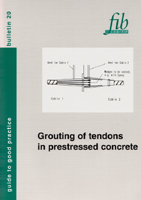Grouting of tendons in prestressed concrete (PDF)
Guide to good practice (52 pages, ISBN 978-2-88394-060-4, July 2002) - PDF format
fib Bulletin No. 20
Title: Grouting of tendons in prestressed concrete
Category: Guide to good practice
Year: 2002
Pages: 52
Format approx. DIN A4 (210x297 mm)
ISBN: 978-2-88394-060-4
DOI: doi.org/10.35789/fib.BULL.0020
Abstract: Prestressed Concrete is a very efficient form of construction; it takes advantage of the strength of concrete in compression. Developed mainly over the second part of the 20th century, it has proven to be reliable and durable. However, in the 1990's some cause for concern was discovered, first in the UK and followed by many other countries of the world. It appeared that the grout, an important means of protection of the steel against corrosion for internally ducted tendons, was in some cases inadequate.
Major investigations followed including physical intrusive examination of ducts, mainly in bridges, and re-writing of procedures, processes and specifications, and in 1998 FIP launched a Task Group to review their advice note "Guidelines for Grouting" which had first been published in 1990. The merger of FIP and CEB in 1998 brought this under the auspices of fib. Structural deficiencies have only been found in a small number of bridges and in most of these cases the cause is clearly identifiable as either design detailing, workmanship or materials.
In the UK, the Concrete Society report TR47 "Durable Post-tensioned Concrete Bridges" had been published in 1996, which was the culmination of four years of investigative research, and contained major new specifications and procedures aimed at improving the quality of grouting.
In the USA, the Post Tensioning Institute published in 2001 their guide "Specification for Grouting of Post-Tensioned Structures", which also represented major steps forward in materials and testing requirements. The American Segmental Bridge Institute has set up a Committee to re-examine their guidelines, as have many other National Bodies worldwide.
In Europe, France has issued a "Fascicule No. 65A" covering requirements for grouting and there are many developments in hand in other countries.
Also in Europe, a European Technical Approval Guideline (ETAG) has been published for approval of post-tensioning systems which covers several aspects of grout and grouting.
In November 2001 an international workshop was held in Ghent, Belgium on "Durability of Post-Tensioning Tendons" [see fib Bulletin 15] at which international experience was exchanged. The theme was clearly apparent; those bridge owners that have looked, have found some problems with a few of their post-tensioned bridges. In most cases steps are being taken to repair existing bridges, where considered necessary, and to improve future construction by reviewing national specifications.
Emphasis is being put on a multi-layer protection strategy whereby protection against corrosion is provided by waterproofing, dense impermeable concrete, sealed ducts and good quality grout. Design detailing and rain water management are seen as important aspects.
It was, therefore, timely for fib to publish state-of-the-art guidelines to assist in developing and improving the quality of a major line of defence against corrosion, the cement grout. This document represents a consensus view of current practitioners of what is a rapidly developing awareness of some of the shortcomings of previous practice and suggests improvements. This document is a major update of the previous FIP Guidelines and may be taken as a future basis for updating EN 445-447.
New areas include understanding of the deleterious effects of an unstable grout, bleeding and how to avoid it, the importance of training and proper procedures, mix design and testing/trials and some new test procedures. It is now understood and generally accepted that the properties of common grout made from cement and water can be very variable and sometimes unpredictable and such grout is not recommended.



